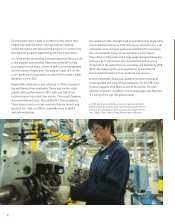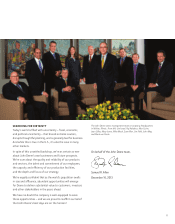John Deere 2013 Annual Report Download - page 20
Download and view the complete annual report
Please find page 20 of the 2013 John Deere annual report below. You can navigate through the pages in the report by either clicking on the pages listed below, or by using the keyword search tool below to find specific information within the annual report.
BUSINESS SEGMENT AND GEOGRAPHIC AREA RESULTS
Worldwide Agriculture and Turf Operations
The agriculture and turf segment had an operating profit of
$3,921 million in 2012, compared with $3,447 million in 2011.
Net sales increased 13 percent in 2012 primarily due to higher
shipment volumes and improved price realization, partially
offset by the unfavorable effects of foreign currency translation.
The increase in operating profit was primarily due to higher
shipment volumes and price realization, partially offset by
increased production and raw material costs, unfavorable effects
of foreign currency exchange, increased research and develop-
ment expenses and higher selling, administrative and general
expenses. The increase in production costs was primarily related
to new products, engine emission requirements and incentive
compensation expenses.
Worldwide Construction and Forestry Operations
The construction and forestry segment had an operating profit
of $476 million in 2012, compared with $392 million in 2011.
Net sales increased 19 percent in 2012 primarily due to higher
shipment volumes and improved price realization. The operat-
ing profit improvement in 2012 was primarily due to price
realization and higher shipment volumes, partially offset by
increased production and raw material costs, increased research
and development expenses and higher selling, administrative
and general expenses. The increase in production costs was
primarily related to new products, engine emission require-
ments and incentive compensation expenses.
Worldwide Financial Services Operations
The operating profit of the financial services segment was
$712 million in 2012, compared with $725 million in 2011.
The decrease in operating profit was primarily due to increased
selling, administrative and general expenses, higher reserves
for crop insurance claims and narrower financing spreads,
partially offset by growth in the credit portfolio and a lower
provision for credit losses. Total revenues of the financial
services operations, including intercompany revenues, increased
3 percent in 2012, primarily reflecting the larger portfolio.
The average balance of receivables and leases financed was
10 percent higher in 2012, compared with 2011. Interest expense
decreased 4 percent in 2012 as a result of lower average
borrowing rates, partially offset by higher average borrowings.
The financial services operations’ ratio of earnings to fixed
charges was 2.25 to 1 in 2012, compared with 2.22 to 1 in 2011.
Equipment Operations in U.S. and Canada
The equipment operations in the U.S. and Canada had an
operating profit of $3,836 million in 2012, compared with
$2,898 million in 2011. The increase was due to higher
shipment volumes and improved price realization, partially
offset by increased production and raw material costs, increased
research and development expenses and higher selling, adminis-
trative and general expenses. Net sales increased 20 percent in
2012 primarily due to higher shipment volumes and price
realization. The physical volume of sales increased 14 percent,
compared with 2011.
Equipment Operations outside U.S. and Canada
The equipment operations outside the U.S. and Canada had
an operating profit of $561 million in 2012, compared with
$941 million in 2011. The decrease was primarily due to higher
production and raw material costs, the unfavorable effects of
foreign currency exchange, increased selling, administrative and
general expenses and higher research and development expenses,
partially offset by the effects of higher shipment volumes and
improved price realization. Net sales were 5 percent higher in
2012 primarily reflecting increased shipment volumes and price
realization, partially offset by the effect of foreign currency
translation. The physical volume of sales increased 7 percent,
compared with 2011.
CAPITAL RESOURCES AND LIQUIDITY
The discussion of capital resources and liquidity has been
organized to review separately, where appropriate, the company’s
consolidated totals, equipment operations and financial services
operations.
CONSOLIDATED
Positive cash flows from consolidated operating activities in
2013 were $3,254 million. This resulted primarily from net
income adjusted for non-cash provisions, which were partially
offset by increases in receivables related to sales and inventories,
excluding non-cash activities. Cash outflows from investing
activities were $4,821 million in 2013, primarily due to the
cost of receivables (excluding receivables related to sales) and
cost of equipment on operating leases exceeding the collections
of receivables and the proceeds from sales of equipment on
operating leases by $3,204 million, purchases of property
and equipment of $1,158 million and purchases exceeding
maturities and sales of marketable securities by $182 million.
Cash inflows from financing activities were $407 million in
2013 primarily due to an increase in borrowings of $2,525
million, partially offset by repurchases of common stock of
$1,531 million and dividends paid of $753 million. Cash and
cash equivalents decreased $1,148 million during 2013.
Over the last three years, operating activities have
provided an aggregate of $6,748 million in cash. In addition,
increases in borrowings were $10,874 million, proceeds from
sales of businesses were $963 million, proceeds from issuance
of common stock (resulting from the exercise of stock options)
were $406 million. The aggregate amount of these cash flows
was used mainly to acquire receivables (excluding receivables
related to sales) and equipment on operating leases that
exceeded collections of receivables and the proceeds from sales
of equipment on operating leases by $7,027 million, repurchase
common stock of $4,786 million, purchase property and
equipment of $3,534 million, pay dividends of $2,044 million
and purchase marketable securities that exceeded proceeds from
maturities and sales by $1,419 million. Cash and cash equiva-
lents decreased $287 million over the three-year period.
20
























